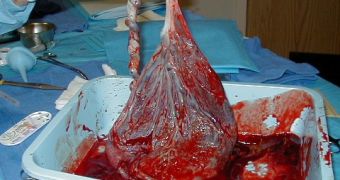You could have been born weighing a few grams and as big as a bean or yuckier from a soft-shelled egg...
But instead of carrying you into a marsupium, your mother delivered a 3-5 kg (8-13 pounds) hunk, resembling a human being (more or less).
That's because she fed you through an organ called placenta ("pie" in Latin) while inside her womb.
In fact, most modern mammals are placental (they possess a placenta and give birth to well developed offspring). The only exceptions are the marsupials from Australia and America and monotremes (platypus and echidna from Australia, which lay eggs).
The problem evolutionists face is when the placental mammals did emerge as there is an absence of definitive placental fossils deeper into the Cretaceous.
Paleontological and morphological analysis supports a first radiation of placental groups of mammals not very far before the Cretaceous-Tertiary (K-T) boundary about 65 million years ago, when dinosaurs went extinct.
Molecular researches have pointed to significantly older roots for many superordinal groups and that some extant orders boomed before the K-T boundary. But this discrepancy is based more on assumptions like abrupt speeding of evolutionary rate linked with convergent evolution in molecular level.
But a new more robust approach, made by a Japanese team led by Dr. Kitazoe, found a strong and short-term speeding of mitochondrial genome in the lineage leading to Laurasiatheria, a large group of placentals, compassing carnivores, bats, cetaceans, ungulates and hedhehogs.
The new research places the root of the placental mammals about 84 million years ago (Upper Cretaceous) instead of 122 million years ago (Lower Cretaceous).
This analysis matches the quantitative analysis of fossil record and traditional morphological hypotheses. The research team stresses the importance of adopting approaches that rely little on assumptions of molecular evolution.

 14 DAY TRIAL //
14 DAY TRIAL //